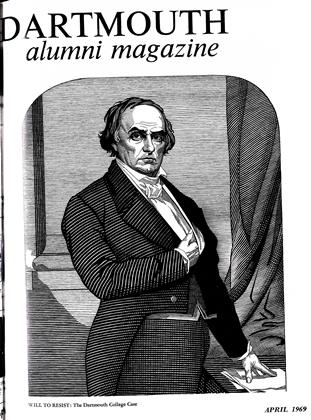By LowellThomas and Lowell Thomas Jr. '46. Garden City: Doubleday and Company, Inc.,1968. Illustrated. 340 pp. $6.95.
"This is the last great long-distance flight to be made on this earth between two continents." said Lowell Thomas to Admiral James Reedy in 1963 as they took off on the first flight from Africa to New Zealand by way of Antarctica.
This awareness of history in the making is typical of Lowell Thomas. I have known "Tommy" - as he was nicknamed by our mutual friend Dale Carnegie - for almost thirty years. No man has a more acute sense of history as it is being made. Both Lowell senior and junior are true men of action. And they know it when they see it.
Famous First Flights is great. It is history, romance, and high adventure. By means of crisp language and colorful detail we learn what it was like to fly the dangerous, uncharted routes of the world by those men who pioneered the age of flight.
We cross the Atlantic for the first time in 1919 with the Englishmen, Alcock and Brown. With Alcock at the little plane's controls, we cling with Brown to an icy wing as the daring flyer tries to repair a broken radio transmitter.
In 1924, we start out with four U.S. Army planes to circle the globe by air, as Magellan did by sea. Accident succeeds accident, and it is only sheer guts that brings success to the two battered planes - out of the orig- inal four - which finally make it home again after fifteen days around the world.
We are sympathetic and anxious for the quiet midwesterner who lifts his pet kitten out of the cockpit just before take-off on a long flight. No use risking the little animal's life, too, reasoned young Lindbergh.
And there is sadness and gladness after the first flight to the North Pole by Byrd and Bennett in 1926. When the young flyers returned in triumph to their base camp at Spitzenberg, the first man to congratulate them was Amundsen, the Norwegian explorer. He had been first to the South Pole in 1911 and had come to Spitzenberg to be first at the North Pole by air. But the Americans beat him to it. The old Viking's disappointment must have been deep, but he generously led his party in "nine Viking cheers" for the winners.
These famous first flights, and many more, make up this fascinating book on the his' tory of the skies. It covers the progress of aviation from the earliest "seat-of the-pants" flying (when wind velocity was decided by the direction of cigarette smoke) to the superjet's performance of long-range miracles.
This book ends with Lowell Thomas Jr.'s first person account of the 1965 flight of the Polecat which circumnavigated the world by way of both poles, a flight which made history by being the last great "first" in terrestrial aviation.
In the early days Mr. Storer, better knownas Doug Storer, President of Amazing ButTrue!, Inc., in a bi-plane flying from Londonto Paris missed houses by inches when heand his pilot fought for altitude. This, hisfirst flight, took two hours and a half.
 View Full Issue
View Full Issue
More From This Issue
-
 Feature
FeatureWILL TO RESIST
April 1969 By RICHARD W. MORIN '24 -
 Feature
FeatureThe New Dean of the College...
April 1969 -
 Feature
FeatureCongress Authorizes National Medal
April 1969 -
 Class Notes
Class Notes1933
April 1969 By ERNEST S. DAVIS JR., WESLEY H. BEATTIE -
 Class Notes
Class Notes1930
April 1969 By CHARLES V. RAYMOND, G. WARREN FRENCH -
 Class Notes
Class Notes1955
April 1969 By JOSEPH D. MATHEWSON, RANDOLPH J. HAYES
Books
-
 Books
BooksFACULTY PUBLICATIONS
November 1942 -
 Books
BooksAlumni Articles
OCTOBER 1965 -
 Books
BooksEDMUND NILES HUYCK
January 1936 By A. Howard Meneely -
 Books
Books"GOOD EYES FOR LIFE."
April 1934 By E. H. Carleton, M.D. -
 Books
BooksTHE FAIR RATE OF RETURN IN PUBLIC UTILITY REGULATION
October 1932 By James P. Richardson -
 Books
BooksTheir Message
May 1980 By Laurence L. Edwards

